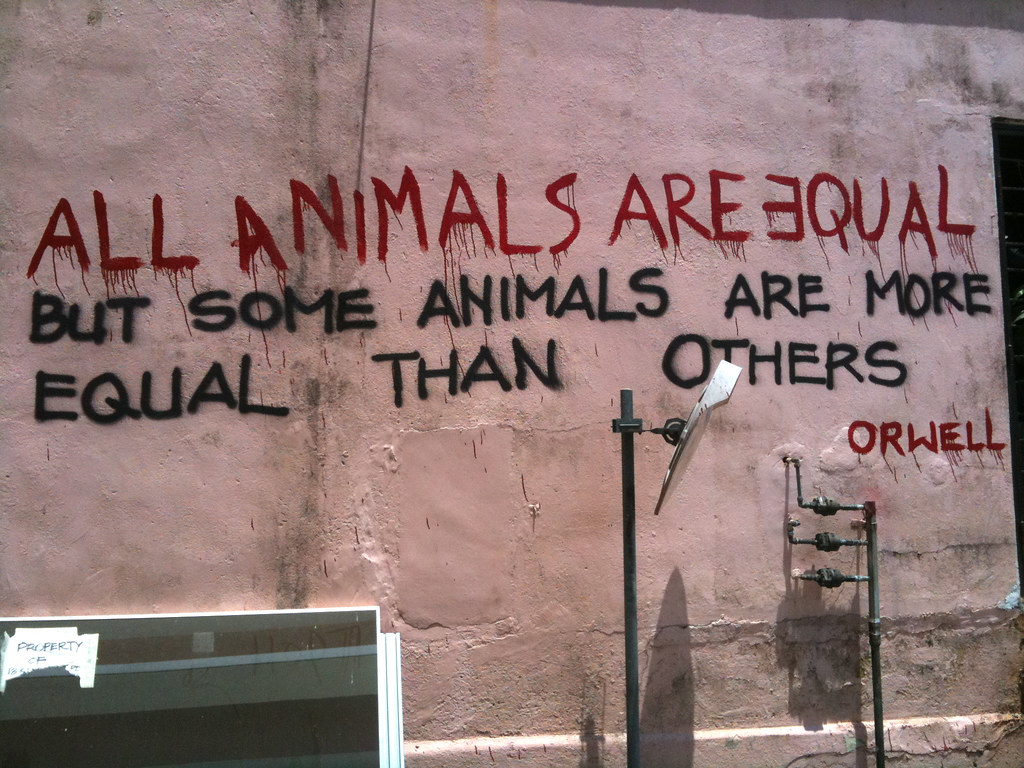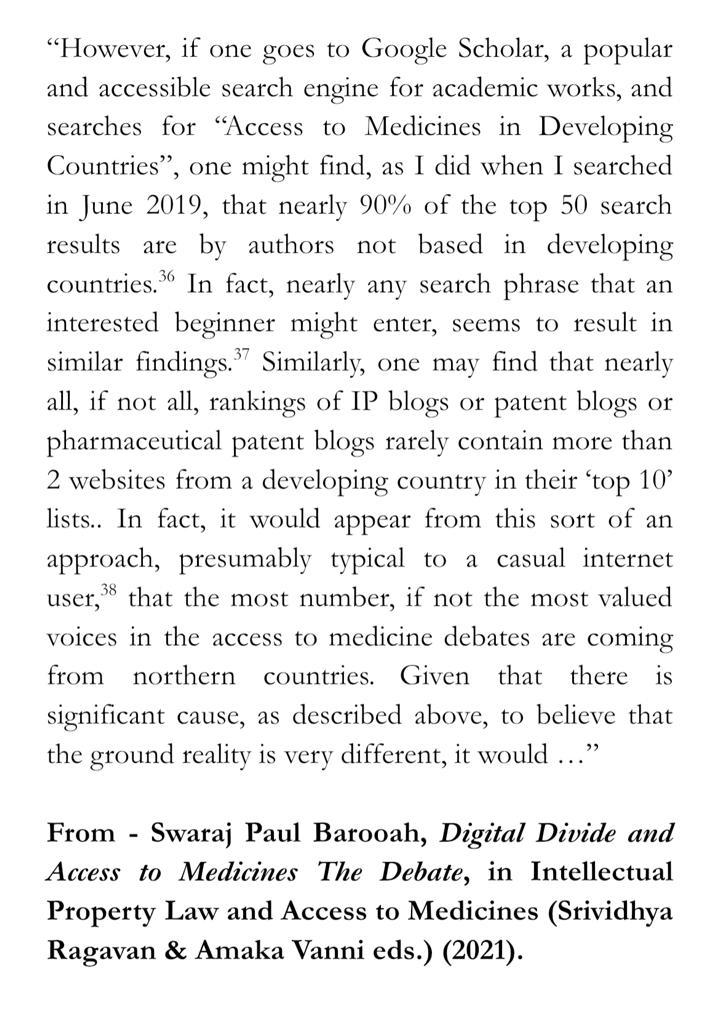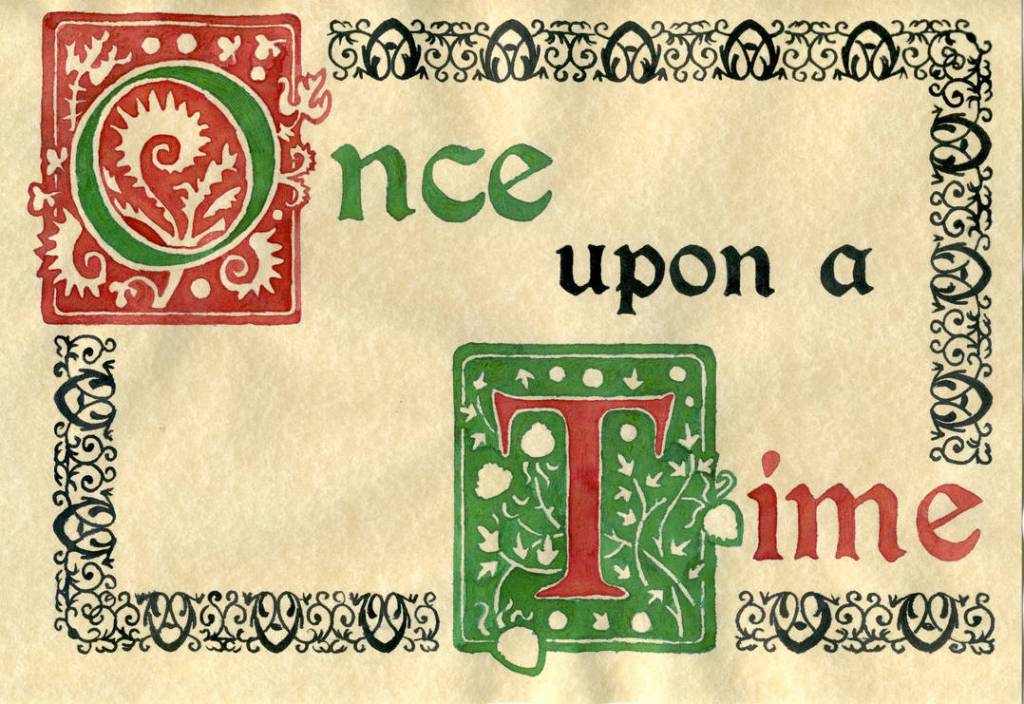
Source – From Flickr’s Kevin Lim
“Are Some Scholars More Equal than Others?,” a question that Prof. Basheer raised in his 2018 post on the Politics of Patent Citation. While the question made sense ever since I read the post, it started making more sense (and bothering me more) after working on the SpicyIP Open IP Syllabus where I witnessed a relative “over-accessibility” of US-European IPR scholarship. Gladly, I “could” witness it because Swaraj instructed us to be conscious of the location of the scholars and the focused regions of scholarship. Otherwise, everything appeared hunky-dory at first. One of the things we were told to keep in mind, was to ensure that scholars from the Global South received appropriate visibility. This turned out to be a very challenging task, however. And finding works from women scholars from this region was even more difficult. I began to wonder – are there actually fewer IP scholars in India (or the Global South in general)? Is it genuinely challenging to find them, or am I not putting in enough effort?

The query resurfaced during my current Ph.D. research on the genealogy of copyright’s balance metaphor. And I found some papers saying that researchers based in the Global North typically enjoy broader global influence and are generally considered to be leading in terms of knowledge generation and dissemination. (See also here). While there are various factors affecting the issue of knowledge governance, understanding when IP became an academic discipline in India can be a useful point of inquiry. For this, I did some research and conversed with some senior and young Indian academics. In this post, I share some of my insights and request our readers to share their thoughts for further engagement.
Please know that this is not exhaustive or conclusive research but more of an introductory post aiming to raise discussion on this point and receive a direction. Also – please note this is longer than our usual posts, but breaking this into parts seemed to be breaking the flow and narrative. So, I hope this one post, even if longer, is more effective at conveying this information and raising appropriate questions.
Before I dish out details, it needs to be highlighted that while IP research and teaching might have been lacking before the 2000s, the “scholarly” spirit in this field has been present nonetheless as evident from several judgments, articles (though very limited), parliamentary discussions, and reports like the Justice N. R. Ayyangar Committee report, 1959. (See generally, SpicyIP’s resource page) Similarly, Kumar Sen Prosanto wrote The Law Of Monopolies In British India in 1922 on the very issue of IP.
Some Details: From World IP Teaching/Research to Indian IP Teaching/Research
Worldwide: The earliest information I could discover regarding IP teaching is from the opening address of Lakshman Kadirgamar (then Director, Development Corporation and External Relations Bureau for Asia and the Pacific, WIPO) in ATRIP’s 1987 Regional Symposium in Beijing. Mr. Kadirgamar traces it back to 1970 when WIPO conducted two surveys: one, on the teaching of industrial property law and the second on the teaching of copyright law teaching. These surveys mentioned the number, subject matter, level, hours, and kind of instruction and related aspects concerning the courses given in various universities and other institutions of higher learning in some 30 countries of the world. Subsequently, in 1979, a meeting of 13 professors from different countries took place, which included Prof. Upendra Baxi (India), Prof. Ernesto Aracama Zorraquín (Argentina), Prof. Manuel Pachon (Colombia), Prof. Jean-Jacques Burst (France), Prof. Friederich-Karl Beier (W. Germany), Prof. Mohammed Hosny Abbas (Kuwait), Prof. David Rangel Medina (Mexico), Prof. Baldo Kresalja Rossello (Peru), Prof. Esteban Bautista (The Philippines), Prof. Januz Swaja (Poland), Prof. Alberto Bercovitz Rodriguez-Cano (Spain), Prof. William Cornish (UK), and Prof. Glen E. Weston (USA). From one of the recommendations of this meeting emerged the “International Association for the Advancement of Teaching and Research in Intellectual Property” aka ATRIP in 1981. Although ATRIP was the first push for IP academization, it would take another 20 years or so, before its goals of IP teaching and research would start getting realized in Asia Pacific countries.
India: To understand the history of IP teaching in India, one needs to know the development stages of Indian legal education as a whole. As Prof. K.I. Vibhute noted that Indian legal education can be understood in three stages:
Phase I (1950-1965) mainly focused on differentiating Indian legal education from its ‘British’ counterpart, making it more ‘Indianised’;
Phase II (1966-75) witnessed attempts to restructure curricula and pedagogy within professional legal education; and
Phase III (1976-1999) was dedicated to the ‘modernization’ of both law curricula and the implementation of structural reforms in legal education, aiming for a more ‘intensive,’ ‘focused,’ and ‘socially relevant’ discipline.
And, if I may add a 4th stage,
Phase IV (2000–Present) has over 25 NLUs and many large private universities now. The approach to legal education appears to have shifted, however. While teaching a diverse range of subjects, the initial mission of NLUs seems to have transformed, with many focusing (inadvertently or not) on converting law schools into corporate law job factories! For, placements play an important role in better law school ranking. The higher the package, the better it is for college ranking and reputation!
IP Teaching Came in Phase 2, but …

While IP teaching entered Indian legal education in Phase II, it gained prevalence in Phase III. The status of IP teaching and research was dire in many countries in the 1980s, suggested the participants in the ATRIP’s Regional Symposium on Intellectual Property Law Teaching and Research in Asia and the Pacific, held at Peking University, Beijing, in November 1987. In this symposium, Professors Narmada Khodie (then Head, Department of Law, University of Bombay, India) and K. Ponnuswami (then Dean of the Faculty of Law, Delhi University) represented India and presented an excellent short report on the status of IP teaching and research in India.
As the report reveals, IP first became a teaching subject at Delhi University in 1967 (Phase II) after the recommendation of a committee report (which I couldn’t find. Please let us know if any reader is aware of the same). As a minor point of difference, Prof S.K. Verma, another Indian professor from DU who was also the president of ATRIP (2001-2003), mentions this as starting in 1968 (as opposed to 1967) in a separate report on IP teaching in India. Regardless, it remained an optional course. Between 1967 and 1987, as the above report says, IP existed as an optional subject for LLB students in many universities namely the University of Agra, University of Aligarh, University of Banaras, University of M S, Baroda, University of Bharathiar, University of Bombay, University of Delhi, University of Garhwal, University of Gorakhpur, University of Kerala, University of Madras, University of Meerut, University of Panjab, University of Patna, University of Poena, University of Ranchi, University of Rohilkhand, University of Saurashtra, University of Shivaji, University of South Gujarat, and University of Simla, H.P.
This time, very few professors taught IP. Why? The reason is simple: IP Professor or IP Specialist initially meant those who practiced it, who were, anyway, very limited. Out of those limited numbers, even fewer taught. Moreover, as the 1987 report notes, IP litigation was very limited at that time, except for trademark law. Generally, a country that produces (and exports) more IPs, will be more impelled to teach and take care of IP policies. India, a net importing country, wasn’t in that category then. It bears noting, however, that the creative industry (particularly the film and music industry) existed in India, but there weren’t many court cases. Why? A few possible reasons can be the weak bargaining position of creators during those days (?), the overall poverty among the Indian populace (?) which regarded protecting IP as less important (through litigation cost) than serving other needs (?), the larger legal consciousness that made people see IP litigations unworthy of much attention? (Anything else?) In sum, if there was not much economic value and professional usefulness in knowing IP law, the incentive to teach and study IP was less, let alone IP research to develop its theoretical base.
Year 1996 and Push for IP Teaching

That said, there existed, however, a specialist Chair in the field of intellectual property law at the University of Delhi in 1979-1980. Moreover, since 1985, the Annual Survey of Indian Law has included a survey on the developments in the field of IPR. The establishment of NLSIU Bangalore in 1986 (i.e., Phase III) was a big event in this regard which started teaching IP in 1992. Prof. N. S. Gopalakrishnan taught the course at NLSIU. Meanwhile, TRIPS negotiations also happened between 1987 and 1993, with India represented by A. V. Ganesan and Jayashree Watal. However, the Indian government felt a lack of IP knowledge or expertise at the time of preparation for the WIPO Diplomatic Conference on Copyright and Neighbouring Rights, which would happen in December 1996. As Mrs. Bela Banerjee noted in her 2001 report, “At that time [i.e., 1996] the government initiated a process of widespread consultation with all stakeholders before formulating the stand that India was to take at the Diplomatic Conference. It was then that the government realized the need for a large body of well-informed and articulate academics and professionals in the field of IPRs to give competent advice to the government in policy formulation and in international negotiations. It may be recalled that it was the time when the TRIPS Agreement was being brought into force and IPRs have really shed their esoterism and become a subject which affects almost all spheres of human endeavour.”
Prof. N. S. Gopalakrishnan participated in these conferences as an IP expert of the Indian delegation. Dr. R.V.V. Ayyar, the then Additional Secretary to Govt of India, Dept of Higher Education, who headed the Delegation played an instrumental for the promotion of IP teaching and research as he felt the need for IP experts during the preparation of the Diplomatic Conference. (Who knew then, that after 25 years, Dr. Ayyar would write an Open Access Book on the Negotiating History of the WCT and WPPT.) After this realization, the government first addressed selected universities, IITs, IISc, and IIMs, in April 1996, and requested them to set up multidisciplinary IPR groups in their universities. Resultantly, some IITs (Mumbai, Delhi, Guwahati, Kanpur, Kharagpur, and Madras), IIMs (Banglore and Ahmedabad), NLSIU, and some Universities (Hyderabad, Madras, Calcutta, Aligarh, Baroda, and Cochin) established such groups.
After the WIPO Diplomatic Conference, a seminar was organized by the government in collaboration with the NLSIU and the IIT, Delhi to study the implications of the new treaties for the country. It also decided to develop a systematic study of IPRs and recommended networking of institutions in IPR studies and organizing a workshop for developing an IPR curriculum. Then, an 8-day workshop was organized at NLSIU on IP Law & Practice for teachers and researchers from July 22 to 29, 1997. The goal was to raise awareness among academics in science, technology, management, and economics about the increasing relevance of Intellectual Property Rights (IPRs) in the recent globalized economy. From this workshop emerged a consensus to develop academic courses with diverse durations and content, catering to various client configurations. This workshop also produced syllabi for basic and advanced courses on IPR which would be introduced in the graduate and post-graduate curricula. After this, funding also flowed from the MHRD under the ninth five-year plan to study and research IPR. Finally, the IP teaching/research environment began to flourish. (But did it?)
The result of all these talks and workshops was the establishment of MHRD IP Chairs in 2001 (See Mrs. Bela’s report for the background work and details of IP Chairs). An interesting tidbit here is that this suggestion of the IP Chair first appeared in Professors Khodie and Ponnuswami’s 1987 report along with other suggestions. Then in 2004, IIT Kharagpur’s Rajiv Gandhi School of IP came into being with generous funding from US billionaire Vinod Gupta. Fast forward to 2023, BCI still recognizes IPR as an optional course, though the subject is widely taught in Indian law schools, just the way Prof. Upendra Baxi envisaged in his 1986 article, Copyright Law and Justice in India.
Here’s a hitch, however. While 1996 may have been a year of realization for the Indian government to take IP teaching seriously, the Curriculum Development Centre (CDC) Report in 1990 recommended IPR as a compulsory course. A similar recommendation also came in 1996 at the All India consultative meeting of Bar Councils, Universities, University Grants Commission, and State Governments at Bangalore on reforming professional legal education in October 1996). However, BCI didn’t accept these recommendations in 1997, and its model curriculum placed IPR as an optional subject.
Conclusion If Any?
While there is no empirical or otherwise relevant research that I could find on this topic tracing the history of IP teaching, given the above details, it seems that India (and many countries in Asia and the Pacific countries, as clear from IPMall’s archives) actively started getting into academic discussions about IP only after the 2000s. It’s common to come across papers with broad titles like “IP teaching and research,” but upon closer inspection, they often benchmark the USA’s IP teaching journey, providing a misleading impression of global IP education. Each country and continent has its unique history of IP teaching and research, which holds profound implications for its current scholarship generation and contribution on the global stage.
All this says something about the epistemological (IP) framework underlying our current legal thinking, such as how we approach the subject, whom we cite, and whose ideas we subscribe to. It is high time we cogitate whether this delay has potentially trapped us in an epistemological framework given a canonical body of work that has already developed during or before our entry into IP teaching and research. ‘Tis is important. As Tana and Coenraad remarked on IP teaching in English-speaking Africa: “There [i.e., English-speaking countries, particularly Germany] legal academics have been pondering the theoretical bases of intellectual property for more than a century, and scholars and research institutions have produced academic studies to rival, in complexity and rigor, those in the more mainstream disciplines.” The same couldn’t have happened in the colonized nations or those recovering from the horrors of colonization. It becomes even more important to discuss and document India’s IP History, Open Educational Resources, Open Book Projects (see also here), Open IP Syllabus, Empirical Scholarship Database Series, Fair Use Resources (see also here), etc. Last but not least, I request readers to please write in with their comments, insights, and corrections if any, to help increase discussion and engagement in this area!
Special thanks to Swaraj Barooah who first raised these questions in my mind and with whom I have been discussing these ideas in one or another for the last few years. Thanks to Prashant Reddy for his input and guidance on the topics related to India’s IP history. I am grateful to Prof. NS Gopalakrishnan, Prof. Raman Mittal, and Niharika Salar for sharing their thoughts, experiences, and ideas about IP teaching and research in India. A huge shout out to UNH Law’s IPMall for making the important archival documents available, including the very interesting Global Collection of Interdisciplinary Articles on Teaching IP
Relevant Readings:
- For the (first) brief history of IP teaching and research till 1986, see Prof. Narmada Khodie and Prof. K. Ponnuswami’s Short report on the status of IP teaching and research in India (1987).
- For the background work of IP Chairs and IP teaching reaction post-1996, see INDIA-COUNTRY REPORT by Mrs. Bela Banerjee, Joint Secretary, Department of Secondary and Higher Education, Ministry of Human Resource Development, Government of India.
- For ATRIP’s role and contribution to IP Teaching and research, 30 Years of ATRIP
- For Bar Council’s model syllabus 1997 and other relevant developments in this regard, see Gurjeet Singh, Revamping professional legal education: Some observations on the LL.B curriculum revised by the Bar. Council of India (1990) [Paywalled]
See also:
- For the impact of US scholarships and funding on Indian legal thinking, see Rajeev Dhavan, Borrowed Ideas: On the Impact of American Scholarship on Indian Law (1985). [Paywalled].
- SEO Powered Content & PR Distribution. Get Amplified Today.
- PlatoData.Network Vertical Generative Ai. Empower Yourself. Access Here.
- PlatoAiStream. Web3 Intelligence. Knowledge Amplified. Access Here.
- PlatoESG. Carbon, CleanTech, Energy, Environment, Solar, Waste Management. Access Here.
- PlatoHealth. Biotech and Clinical Trials Intelligence. Access Here.
- Source: https://spicyip.com/2024/01/ip-scholarship-citations-and-knowledge-governance-some-insights-from-the-history-of-intellectual-property-teaching-in-india.html



